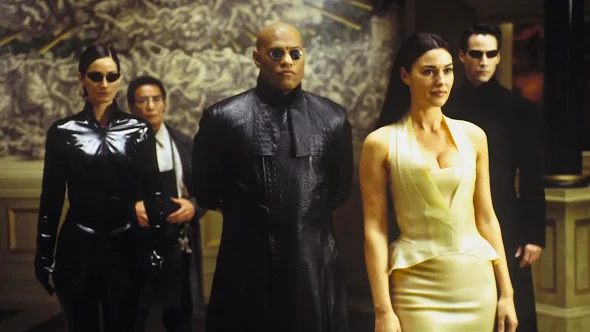
Chris O'Hara has pulled off a lot of incredible feats across his 30 years working as a stuntman-turned-stunt coordinator and second unit director. But perhaps the most incredible of all is earning Hollywood's first-ever "Stunt Designer" credit for his work on The Fall Guy.
"Stunt Designers are the creative architects behind fight scenes, high falls, and more, and deserve to be recognized for the creative leadership of their contributions," said The Fall Guy director David Leitch. "We hope this will pave the way for the stunts industry to get the recognition it deserves."
O'Hara spent the better part of the '90s cutting his teeth as a TV stuntman before graduating to the big screen, working as a stunt performer and double on such iconic action movies as Air Force One, Kill Bill Vol. 1, and The Matrix Reloaded. In the years since, the Bronx native has worked in both the Marvel and DC Cinematic Universes, as well as the Fast & Furious and Jurassic World franchises, among other projects.
After collaborating with Leitch on 2019's Hobbs & Shaw and 2022's Bullet Train, O'Hara was the director's first choice for The Fall Guy, an action comedy starring Ryan Gosling and Emily Blunt that doubles as a love letter to the stunt community. "It was a no-brainer when he called me about the film," O'Hara explains. He was not, however, expecting to make history in the process.
"It's an honor to be recognized this way," O'Hara says of becoming the first stunt designer recognized by the Screen Actors Guild and Directors Guild of America. "Getting designated with this title for the first time further helps all of us, because we are designing all of the stunts in a movie. Our work is on par with what a production designer or costume designer does. We are all designing the look of a movie together, and that was especially the case with The Fall Guy, which is so stunt-centric."
Below, O'Hara looks back on five of the biggest movies of his career.

Directed by: Sam Raimi
Spider-Man 3 was made before superhero movies turned into what they have, which are more VFX-driven blockbusters. We did a lot of stuff practically on that movie, and I think I doubled for almost every character at one point or another, except for Sandman. I regularly got to double for Spider-Man and Venom, and I got the chance to do a lot of really great stuff while we were making that film.
It also solidified my spot in the industry. I worked with [second unit director] Dan Bradley, [stunt coordinator] Scott Rogers, and [stuntman] Darrin Prescott on the movie, and the opportunities I got with them, as well as my own work ethic, really cemented my place amongst them. As Scott and Darrin both became more successful, I eventually slid into a position as Dan's right-hand man, and the foundation for all of that was laid by my experiences on Spider-Man 3.

Directed by: Paul Greengrass
I was still working on another movie when The Bourne Supremacy began shooting, so I missed the first part of that production. But as soon as I was done with that other job, I jumped on a place and flew out to Germany to work on it. My big claim to fame on that movie was that every car crash in the tunnel sequence was done by me. The stunt team would ask, "Do you want to crash this car?" And they'd get told yes, so I just kept getting moved from car to car to car for each crash.
I also got the chance to double Matt [Damon] a lot on that movie, and I traveled around the world for it. I went to the U.K., Italy, Austria, Germany, and India. Making it was absolutely a career highlight for me, and I'm glad to have worked on a franchise that changed cinema in a lot of ways. After those movies came out, I'd go into meetings where people would say, "We want some Bourne-style action." To have been a part of that is still a big highlight of my career.

Directed by: Lana Wachowski and Lilly Wachowski
The Matrix series was another franchise that really redefined cinema, so I'm honored to have been a part of it. I remember when we made The Matrix Reloaded and The Matrix Revolutions, they needed multiple doubles for Hugo Weaving. David Leitch was hired as one, and so was I. A core group of guys ended up forming, and we all sort of came up in the business together.
I worked on Revolutions for 13 months, and a lot of what we did in that time involved training and rehearsal. Keanu had something like a 280-move fight that he had to train for every day, and he did it section by section. We stunt guys were there every day to train with him and make sure he looked the best that he could, and we were all really embraced by him and the film's other actors. We became this family that traveled all the way together from Santa Monica to Sydney. When I think about my career, that's one experience that still really stands out.

Directed by: Michael Bay
Michael Bay is an action god. He just creates insane stuff. His camera work is crazy, and he always wants to do everything in camera that he can. He wants to make his films as big as possible, and he really gives the stunt departments on his movies the resources they need to tell his stories on the big, grandiose scales that he likes. I don't even know how many stunt people worked on Pearl Harbor, but we were all doing epic stuff every day on it.
I was brought down to help out with it, because they were filming a lot of air rams and crashes, and I got one of the greatest pictures of my career out of that film. It was your typical stunt shot in a lot of ways, but there were these Japanese planes flying toward this pier and the whole thing was exploding behind me. So, there's this image of me getting blown up with this huge explosion going off and these two guys doing air rams in the background. It's one of the most incredible shots I've ever gotten to be a part of. Getting to work on something of that scale was amazing, and being brought on to help out on it at a fairly early point in my career made it all the more memorable.
Directed by: Ron Howard
If we're really talking about my career highlights, then I have to include How the Grinch Stole Christmas. In college, I was a gymnast, but I never reached my full potential in gymnastics. When I got out of school, I wanted to keep competing somehow, and my friend invited me to Lake Placid to try out for the U.S. Aerial Ski Team with him. The 10 days I spent there went really well, so he asked me to go to Park City and do some ski jumping with him. My experiences doing that really came in handy when I got to Hollywood, because there ended up being this huge skiing sequence in How the Grinch Stole Christmas that I helped develop and execute. I ended up going back to Park City for that sequence, and we shot a lot of skiing footage while we were there.
Working on that film led to me getting jobs on a bunch of other movies, because it's all word-of-mouth in this business. If you do a good job on one movie, then you get recommended for another, and that's what happened after I worked on Grinch. It was also just a really fun film to get to be a part of. A lot of people watch it every Christmas, including my nieces and nephews, and it's really nice to see that the work you've done hasn't been forgotten.







